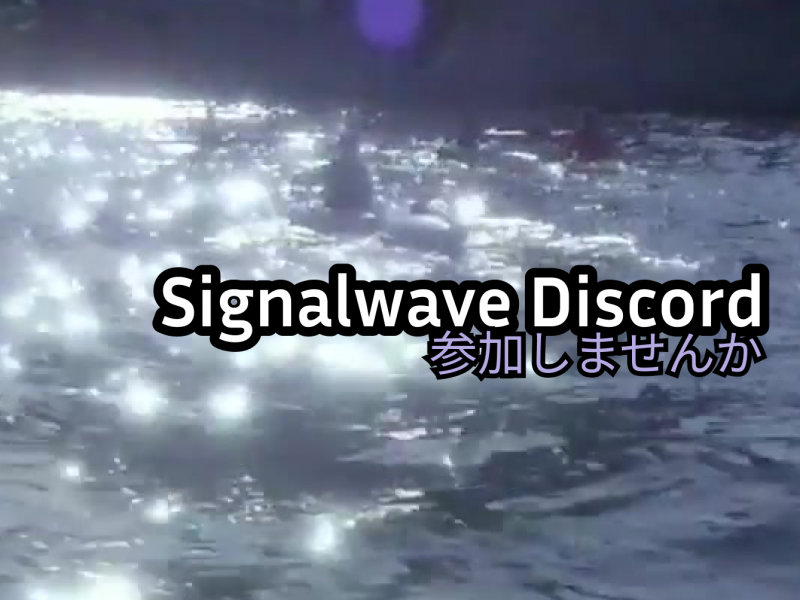In the early 2000s, MiniDiscs were a popular way to listen to music. They were portable, durable, and offered high-quality sound. I remember using MiniDiscs frequently during this time, and it was a great way to listen to my favorite tunes.
To begin with, adding songs to blank MiniDiscs was a straightforward process. You needed a MiniDisc recorder, which was essentially a small portable device that allowed you to record and play MiniDiscs. To add songs, you simply had to connect your MiniDisc recorder to your computer, either through a USB or a special cable. Once connected, you could then transfer your music files onto the MiniDisc. It was an easy process, and the MiniDiscs could hold up to 74 minutes of music.
The quality of the music on MiniDiscs was impressive. The sound was crystal clear, and the MiniDiscs themselves were extremely durable. They were less likely to scratch or skip than CDs or tapes, which made them a popular choice for people on the go. MiniDiscs were also small enough to fit in your pocket, which made them easy to carry around with you.
In addition to buying blank MiniDiscs, people would often trade MiniDiscs with each other. This was a popular way to discover new music and to share your favorite tunes with others. Trading MiniDiscs was also a great way to save money, as you could trade a MiniDisc that you no longer wanted for one that you did. It was a win-win situation for everyone involved.
The trading of MiniDiscs was done in a variety of ways. Some people would meet up in person and exchange discs, while others would mail them to each other. There were also online forums and chat rooms dedicated to MiniDisc trading. These forums allowed people from all over the world to connect with each other and share their music.
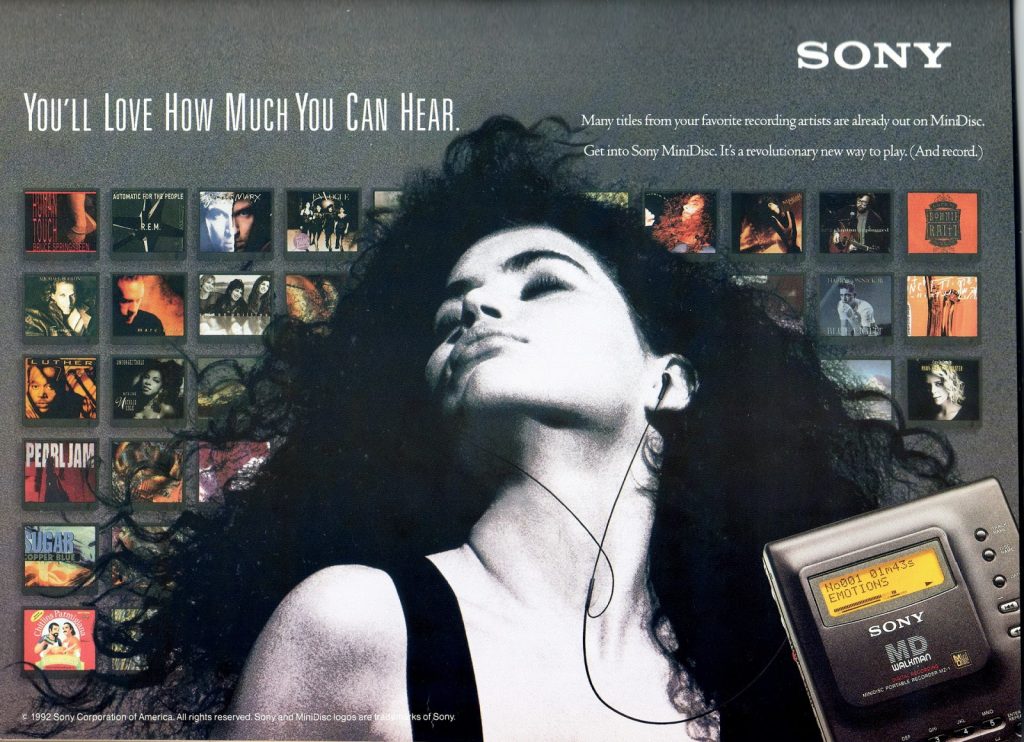
One of the most exciting things about MiniDisc trading was the discovery of new music. People would often share music that was not widely known, and this allowed others to expand their musical horizons. It was also a great way to find rare and hard-to-find music. I remember trading MiniDiscs with a friend who was a big fan of Japanese rock music. He introduced me to bands that I had never heard of before, and it was a great experience.
MiniDiscs were also popular among DJs. They allowed DJs to create and mix their own tracks, which was not possible with CDs or tapes. DJs would often use MiniDiscs to record live performances or to create mixtapes. MiniDiscs were also less expensive than other recording media, which made them a popular choice for up-and-coming DJs. Some of the most popular MiniDiscs in North America during the early 2000s included:
- Madonna – Music
- Radiohead – Kid A
- Eminem – The Marshall Mathers LP
- Nirvana – Nevermind
- Coldplay – Parachutes
- U2 – All That You Can’t Leave Behind
- Outkast – Stankonia
- The Strokes – Is This It
- The White Stripes – White Blood Cells
- Linkin Park – Hybrid Theory
During the early 2000s, MiniDiscs were particularly popular in Japan, where they were widely used as a portable music format. In fact, MiniDiscs were first introduced by Sony in Japan in 1992 and quickly gained popularity as a portable music format due to their small size, durability, and high-quality sound.
Some of the top-selling MiniDiscs in Japan during the early 2000s included:
- Utada Hikaru – Distance
- Ayumi Hamasaki – A Best
- Mr. Children – Q
- B’z – The Best “Pleasure”
- L’Arc-en-Ciel – Smile
- Glay – Drive -Glay Complete Best-
- Hikaru Utada – Deep River
- Dreams Come True – Do You Dreams Come True?
- Amuro Namie – Best Fiction
- Southern All Stars – Umi no Yeah!!
These MiniDiscs were primarily Japanese-language releases by popular J-pop and J-rock artists. Many of these artists had dedicated fan bases who purchased their music on MiniDiscs as well as other formats such as CDs and cassettes.
Overall, the popularity of MiniDiscs in Japan gradually declined throughout the 2000s as digital music formats such as MP3s and iPods became more prevalent. However, MiniDiscs remain a nostalgic format for many music fans in Japan, and there is still a small but dedicated group of collectors and enthusiasts who continue to use and collect MiniDiscs today.
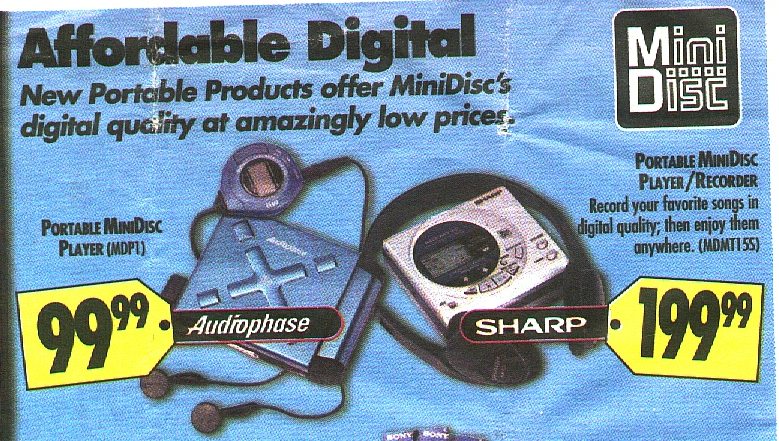
MiniDisc in Japan
MiniDiscs were a highly popular music format in Japan during the 1990s and early 2000s. They were first introduced by Sony in 1992 and quickly became a popular alternative to traditional cassette tapes and CDs. The MiniDisc format was a proprietary digital audio format that used lossy audio compression to store audio data on a small, portable disc.
One of the major historic points in the popularity of MiniDiscs in Japan was their use as a portable music format. Unlike CDs or cassettes, MiniDiscs were small, durable, and could hold up to 80 minutes of audio. This made them a popular choice for commuters and students who wanted to listen to music on the go. In addition, MiniDisc players were also popular as home audio systems due to their compact size and high-quality sound.
Another historic point was the launch of the NetMD system in 2001, which allowed users to transfer digital music files from their computers to MiniDiscs. This gave MiniDiscs a new lease of life and allowed users to create custom playlists of their favorite songs on MiniDiscs.
MiniDiscs were also popular in Japan due to their high-quality sound. The MiniDisc format used a lossy audio compression algorithm called ATRAC, which was specifically designed for MiniDiscs. This resulted in high-quality sound that was often considered superior to traditional cassette tapes and sometimes even to CDs.
Despite their popularity in Japan, the MiniDisc format eventually declined in popularity due to the rise of digital music formats such as MP3s and iPods. Sony stopped producing MiniDisc players in 2011, and the format gradually became obsolete.
However, MiniDiscs remain a nostalgic format for many music fans in Japan. They continue to be used and collected by a dedicated group of enthusiasts who appreciate the format’s unique sound quality and portability. In fact, there are even some artists who continue to release their music on MiniDiscs for their fans in Japan.
Overall, the importance of MiniDiscs in Japan lies in their unique place in the country’s music culture. They were a popular format during a specific era in Japanese music history and remain a cherished artifact of that time.
Japan was the biggest market for MiniDiscs, and the format enjoyed a much longer and more widespread popularity in Japan than in other countries. As a result, there were several unique developments and events related to MiniDiscs that were specific to Japan. Here are some examples:
- Exclusive Japanese MiniDisc releases: Many Japanese artists released their music exclusively on MiniDiscs, particularly during the 1990s and early 2000s. Some of these releases included limited edition MiniDiscs that were only available in Japan, making them highly sought-after by collectors.
- MiniDisc karaoke: In Japan, MiniDiscs were also used for karaoke, allowing users to sing along to their favorite songs. MiniDisc karaoke machines were popular in karaoke bars and at home, and there were even MiniDisc karaoke competitions held in Japan.
- MiniDisc anime soundtracks: Anime soundtracks were a popular genre for MiniDiscs in Japan. Many popular anime series, such as Neon Genesis Evangelion, had their soundtracks released on MiniDiscs, often with exclusive bonus tracks or remixes.
- MiniDisc recording: In addition to playing pre-recorded MiniDiscs, MiniDisc players in Japan also had the ability to record audio onto blank MiniDiscs. This made MiniDiscs a popular format for recording and distributing live performances and bootlegs.
- MiniDisc radio programs: Some Japanese radio stations aired MiniDisc-exclusive programs, featuring interviews and live performances by Japanese artists. These programs were often recorded onto MiniDiscs and sold as limited edition releases.
- Overall, MiniDiscs had a unique and enduring place in Japan’s music culture. While the format eventually declined in popularity in Japan as well, it remains a cherished and nostalgic artifact of a specific era in Japanese music history.
The downfall of MiniDiscs
The downfall of MiniDiscs in Japan was due to a combination of factors, including the rise of digital music formats and changes in consumer preferences.
Firstly, the popularity of digital music formats, such as MP3s and iPods, began to increase in the early 2000s. These digital formats allowed users to easily store and transfer music files, which made MiniDiscs seem outdated in comparison. As a result, many music fans in Japan began to shift away from MiniDiscs and towards digital music formats.
Secondly, MiniDiscs faced competition from other physical formats, such as CDs and vinyl records. While MiniDiscs offered several advantages, such as their durability and portability, they were ultimately unable to compete with the convenience and familiarity of CDs and other formats.
Thirdly, changes in consumer preferences and trends also played a role in the downfall of MiniDiscs. As the music industry shifted towards digital distribution and streaming services, physical music formats began to lose popularity. This shift in consumer behavior meant that MiniDiscs were no longer as relevant or desirable as they once were.
In addition, the cost of MiniDisc players and blank discs also contributed to their decline in popularity. While MiniDiscs offered high-quality sound and the ability to create custom playlists, they were often more expensive than other formats, which made them less accessible to casual music fans.
The downfall of MiniDiscs in North America can also be attributed to several factors, including competition from other physical and digital music formats, changes in consumer behavior, and technological advancements.
One major factor was the rise of digital music formats, such as MP3s and streaming services. These formats allowed users to easily and conveniently access and transfer music, which made MiniDiscs seem outdated in comparison. As a result, many consumers in North America began to shift away from MiniDiscs and towards digital music formats.
In addition, MiniDiscs faced competition from other physical formats, such as CDs and vinyl records, which were more widely available and more familiar to consumers. While MiniDiscs offered several advantages, such as their durability and portability, they were ultimately unable to compete with the convenience and accessibility of these other formats.
MiniDisc Hobbyist
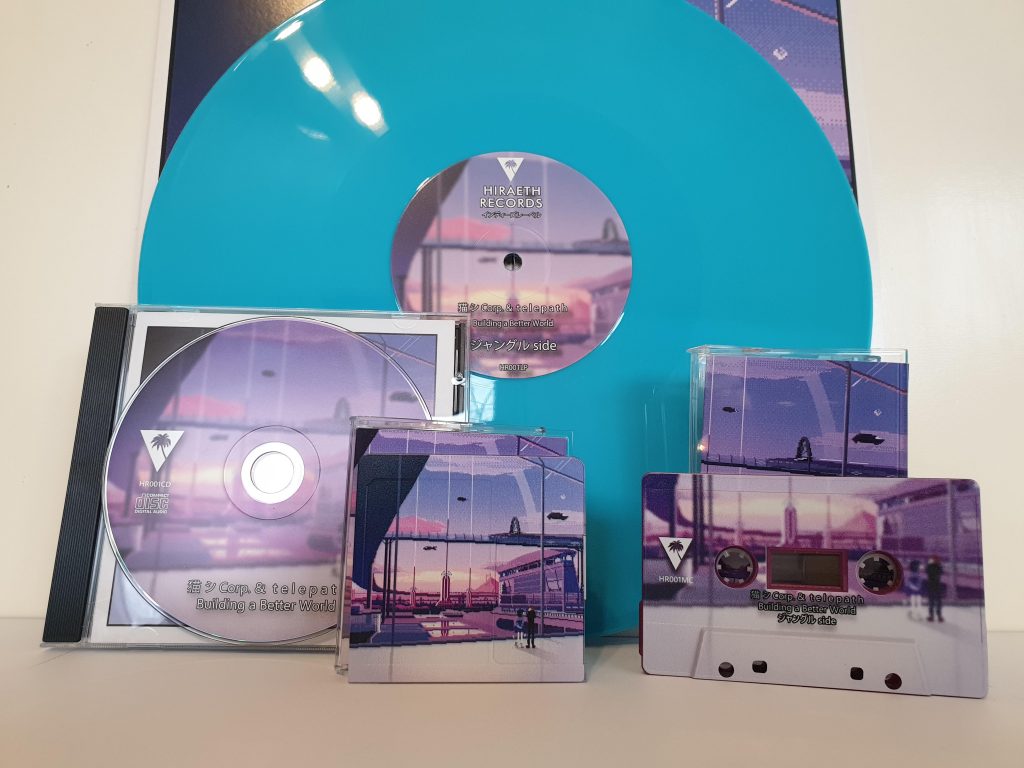
In recent years, there has been a growing interest in retro technology and music formats within the vaporwave community, a genre of electronic music that emerged in the early 2010s. One aspect of this resurgence in retro tech is the renewed interest in MiniDiscs among hobbyists and collectors.
MiniDiscs were first introduced in the early 1990s as a new form of digital audio storage. They offered several advantages over other formats, such as their compact size, durability, and ability to create custom playlists. However, as digital music formats and streaming services gained popularity, MiniDiscs began to decline in popularity in the early 2000s.
Despite their decline, MiniDiscs have experienced a resurgence in recent years among retro tech enthusiasts and vaporwave fans. This renewed interest in MiniDiscs can be attributed to several factors.
The physicality of MiniDiscs is attractive to collectors and hobbyists. Unlike digital music files, which can be easily replicated and shared, MiniDiscs are a physical object that can be held and admired. Additionally, the act of creating a custom playlist on a MiniDisc is a hands-on and creative process that many enthusiasts find enjoyable.
MiniDiscs have a unique sound that some listeners prefer over other formats. The compression used in MiniDiscs results in a distinctive sound that is often described as warm and rich. This sound has a nostalgic quality that appeals to many vaporwave fans and collectors.
The limited availability of MiniDiscs and MiniDisc players adds to their appeal among collectors. Unlike CDs and vinyl records, which can be easily found in second-hand stores and online marketplaces, MiniDiscs and players are rarer and harder to come by. This scarcity adds to their value and makes them more sought after by collectors.
The resurgence of MiniDiscs among hobbyists and collectors has also led to an increase in demand for blank MiniDiscs and MiniDisc players. As a result, prices for these items have risen in recent years, with some rare MiniDiscs and players selling for hundreds of dollars on online marketplaces.
The interest in retro technology and music formats is not unique to MiniDiscs. In recent years, there has been a growing interest in cassette tapes, vinyl records, and other analog formats among collectors and enthusiasts. This interest in retro tech is part of a broader cultural trend towards nostalgia and the rediscovery of past technologies and aesthetics.
Within the vaporwave community, the interest in retro tech and music formats is closely tied to the genre’s focus on nostalgia and the re-appropriation of past cultural artifacts. Vaporwave often incorporates samples of music and media from the 1980s and 1990s, and the use of analog formats such as MiniDiscs and cassette tapes fits within this aesthetic.
In conclusion, the resurgence of MiniDiscs among hobbyists and collectors is a reflection of a broader cultural trend towards nostalgia and the rediscovery of past technologies and aesthetics. The physicality, unique sound, and limited availability of MiniDiscs add to their appeal among collectors, and their renewed popularity within the vaporwave community is closely tied to the genre’s focus on nostalgia and the re-appropriation of past cultural artifacts.
Little known facts about MDs
- MiniDiscs were initially developed as a replacement for the compact cassette in the 1990s, but their popularity quickly waned in the early 2000s due to the emergence of digital audio players and other portable storage devices.
- The first MiniDisc was released in 1992 in Japan by Sony, the company that developed the technology. The format eventually spread to other countries, including the United States and Europe, but it was most popular in Japan.
- MiniDiscs were able to hold up to 80 minutes of audio, which was comparable to the storage capacity of a standard audio CD. However, they were much smaller and more portable, which made them a popular choice for music enthusiasts on-the-go.
- MiniDiscs used a lossy audio compression algorithm called ATRAC (Adaptive Transform Acoustic Coding) to store digital audio data. While this compression method allowed for smaller file sizes, it also resulted in some loss of audio quality.
- MiniDiscs were not just limited to audio storage. Sony also developed a variant called MD Data, which allowed for storage of computer files such as documents and photos on MiniDiscs.
- MiniDiscs were not just limited to personal use. They were also used in professional audio settings such as radio stations and recording studios, where their durability and ability to quickly record and transfer audio made them a popular choice.
- In addition to their small size and portability, MiniDiscs also featured some advanced features for the time, such as the ability to create and edit playlists on the device itself.
- Some MiniDisc players even had the ability to record audio directly onto the disc from an external source such as a microphone or another audio device.
- While MiniDiscs were most popular in Japan, they also had a small but dedicated following in other countries, especially among audiophiles and music enthusiasts who valued the format’s unique sound quality.
- Despite being largely phased out by the mid-2000s, MiniDiscs have recently experienced a small resurgence in popularity among collectors and fans of retro technology. This renewed interest has even led to the release of new MiniDisc players and blank discs in recent years.
MiniDiscs in TV/Movies
While MiniDiscs were not a common feature in movies or anime, there are a few notable examples where they appeared:
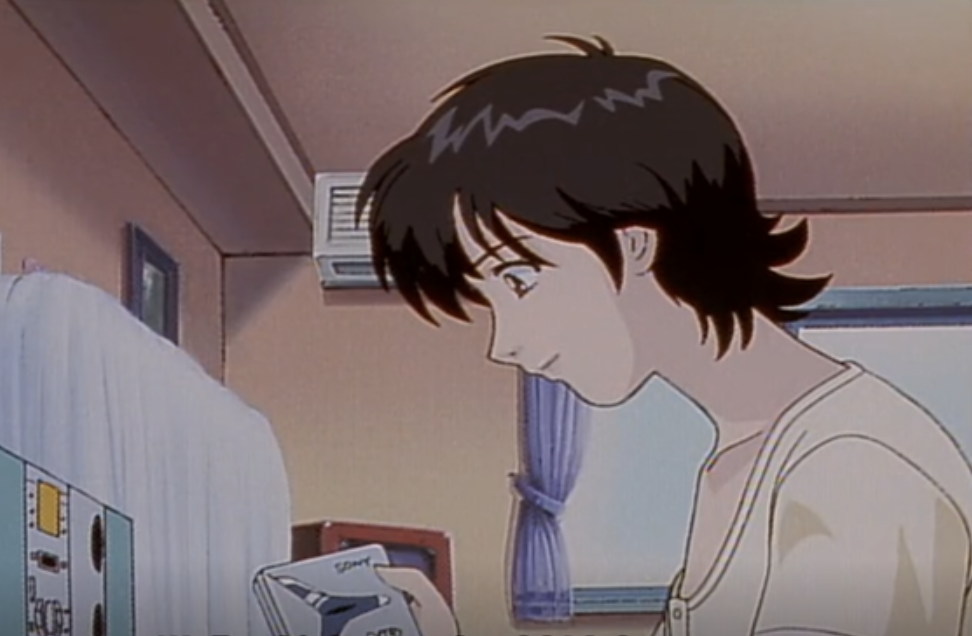
- “Perfect Blue” (1997) – In this psychological thriller anime film directed by Satoshi Kon, the main character Mima Kirigoe is seen listening to music on a MiniDisc player in several scenes.
- “Initial D” (1998-2014) – This popular anime series features a main character who drives a modified Toyota AE86 and listens to Eurobeat music on a MiniDisc player.
- “Cowboy Bebop” (1998) – In episode 2 of this beloved anime series, the main characters use a MiniDisc player to listen to music while they investigate a case.
- “Battle Royale” (2000) – This Japanese dystopian film features a scene where the character Mitsuko Souma listens to music on a MiniDisc player while she is alone in a lighthouse.
- “All About Lily Chou-Chou” (2001) – This Japanese film about the lives of two high school students features a scene where one of the characters listens to music on a MiniDisc player while riding on a bus.
- “Love Hina” (2000) – This anime series features a scene where the character Shinobu Maehara listens to music on a MiniDisc player while walking through town.
- “ReLife” (2017) – In episode 5, the protagonist discovers a box of old MiniDiscs containing music from his high school days, prompting him to reminisce about his past experiences.
While these examples are relatively few, they demonstrate how MiniDiscs were a part of the cultural zeitgeist in Japan and how they were integrated into various forms of media.
Comparing MiniDiscs to PSP UMDs
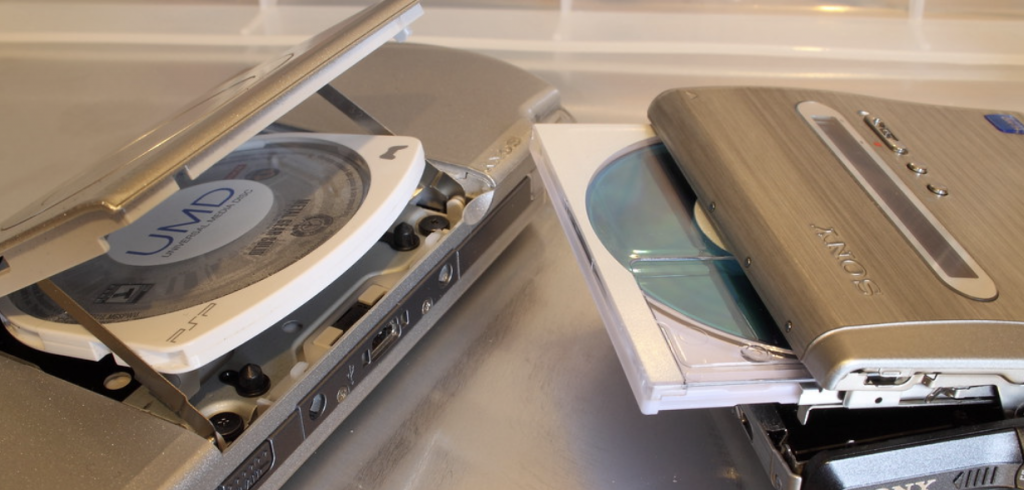
MiniDiscs and PSP UMDs (Universal Media Discs) are two different types of optical storage media that were popular in different eras and for different purposes.
MiniDiscs were primarily used for audio storage and were popular in the 1990s and early 2000s. They were developed by Sony and offered a convenient way to store and play music on a portable device. MiniDiscs had a storage capacity of up to 80 minutes and were able to store digital audio files that were compressed using the ATRAC algorithm. They were smaller and more portable than CDs and offered features like playlist creation and editing on the device itself. MiniDiscs also had some durability advantages, as they were less prone to scratches and damage compared to CDs.
PSP UMDs, on the other hand, were developed by Sony in the mid-2000s as a storage medium for its portable gaming console, the PlayStation Portable (PSP). UMDs were small, portable, and able to hold up to 1.8GB of data, making them ideal for storing and playing video games and other digital media on-the-go. UMDs were a proprietary format and could only be played on the PSP, which limited their versatility compared to other portable storage formats.
While MiniDiscs and UMDs both offered portable storage solutions for digital media, they were designed for different purposes and catered to different audiences. MiniDiscs were primarily for music enthusiasts, while UMDs were targeted towards gamers and other consumers looking for a portable entertainment solution. Additionally, MiniDiscs were a standard format that could be played on a variety of devices, while UMDs were a proprietary format that could only be played on the PSP.
In terms of popularity, MiniDiscs had their heyday in the 1990s and early 2000s, but they were eventually surpassed by digital audio players like the iPod and smartphones. UMDs, meanwhile, were also a relatively short-lived format, as the PSP was eventually replaced by newer gaming consoles like the PlayStation Vita.
In conclusion, while MiniDiscs and PSP UMDs share some similarities as portable storage media, they were developed for different purposes and were popular in different eras. MiniDiscs were primarily for audio storage and were popular in the 1990s and early 2000s, while UMDs were developed for the PSP and were popular in the mid-2000s. Despite their differences, both formats demonstrate the ongoing desire for convenient and portable storage solutions for digital media.
In conclusion, MiniDiscs were a unique and innovative storage medium that revolutionized the way people listened to music in the 1990s and early 2000s. Although they were not as popular in North America as they were in Japan, MiniDiscs were still cherished by audiophiles and music enthusiasts who appreciated their superior sound quality and portability. The MiniDisc format had a lasting impact on the world of music technology, inspiring new advancements in portable music players and digital audio compression algorithms. While the rise of digital music and streaming services eventually made MiniDiscs obsolete, their legacy lives on in the hearts and minds of music lovers and collectors. The resurgence of retro tech in recent years, including the renewed interest in MiniDiscs among hobbyists and vaporwave enthusiasts, is a testament to the enduring appeal of this classic format. As technology continues to evolve at a rapid pace, it is important to remember the contributions and innovations of formats like MiniDiscs that helped pave the way for the digital music landscape of today.

